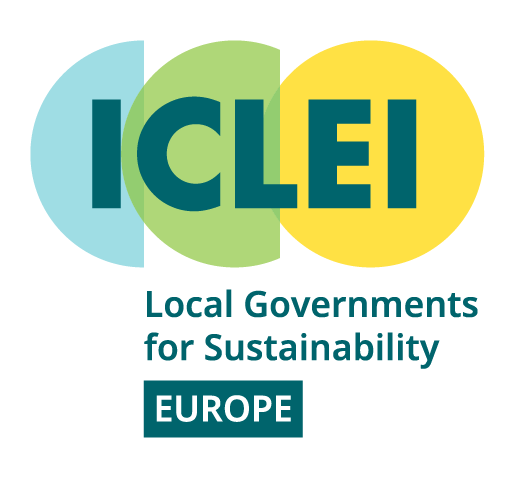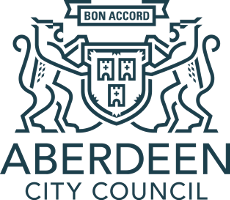Vitoria-Gasteiz
Intro: "Getting to Superblocks"
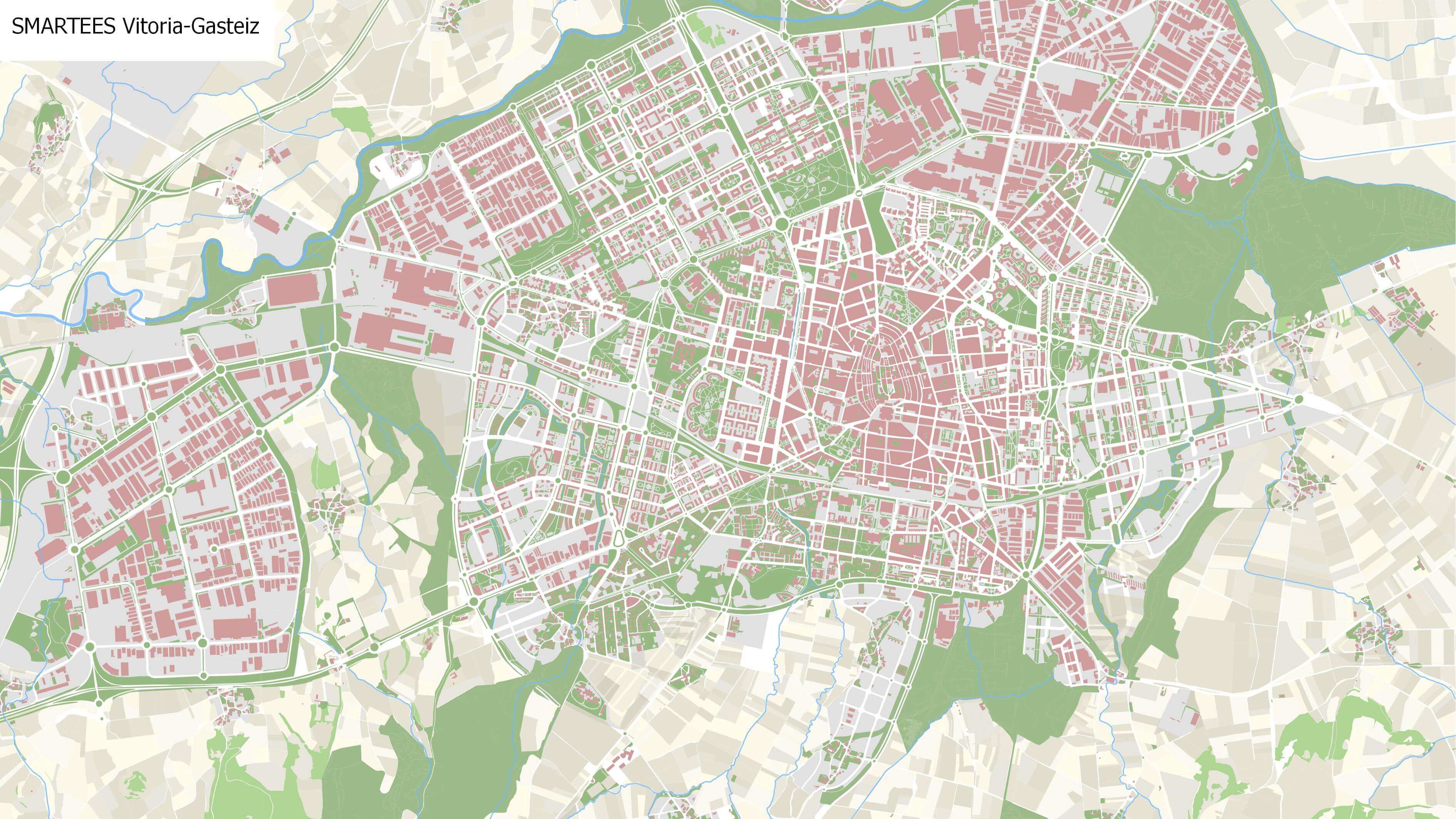
Vitoria-Gasteiz is the administrative capital of the Basque Country, located in the north of Spain. Regarded as a "green" city, it has approximately 50 m2 of green space per capita. The municipality, which is comprised of 63 surrounding villages, is the largest in the region, with a total area of 276.81 km2 and a population of 249,176 inhabitants.
Vitoria-Gasteiz is a pedestrian-scale compact city with a medieval centre. It was one of the first cities in Spain to put in place a network of cycle lanes.
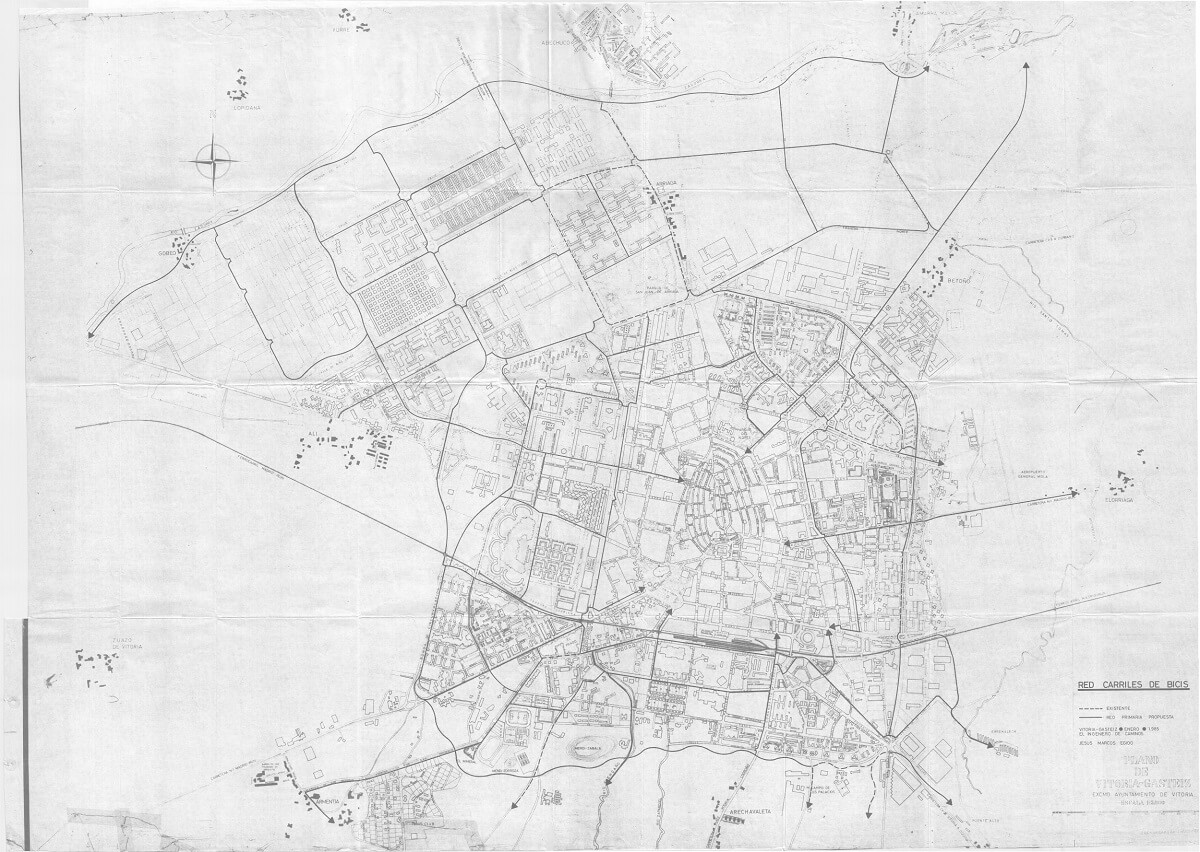
Bicycle lanes map of Vitoria-Gasteiz 1985 © City of Vitoria-Gasteiz
This case shows how a strong commitment towards low-carbon mobility has made Vitoria-Gasteiz a frontrunner city when it comes to implementing the Superblock model.
2006-2007: The Sustainable Urban Mobility Plan

Already in 1998, the actors involved in the Local Agenda 21 realised the upward trend of private car use linked to a foreseen and planned growth of the city. Based on the urban development plans for the next years, up to 9,000,000m2 of new residential areas, with a total of approximately 16,000 homes, were expected.
A 2006 urban mobility survey confirmed the expected growth and indicated an increase in car use. Out of all the journeys made within the city, 49.9% were made on foot (56% in 1996), 36.6% by car (29% in 1996), 7.9% with public transport, and 4% by cycling. The proportion of journeys of less than five kilometres long that were made by private car was 36% in 2006, while those made by bicycle increased steadily from 1.4% in 2001 to 3.3% in 2006.
Based on the survey, a "Diagnosis report on the status of sustainability and the environment in Vitoria-Gasteiz" was published in 2006. One of the main conclusions of this report was that it would be relatively easy to establish a new public space and mobility scheme to minimise the negative environmental and social effects of car-based mobility in the city.
The following actors were involved during this time:
The Vitoria-Gasteiz City Council was the central actor in this case. All political parties in the City Council were involved in the mobility-related discussions and processes.
The Centre of Environmental Studies (CEA) is a municipal autonomous entity whose mission is to foster the municipality's sustainable development, such as in the Local Agenda 21 and educational projects.
The Barcelona Urban Ecology Agency (BCN ECO) played an essential role in the planning of the Superblock approach by providing technical support.
The Citizens' Forum for Sustainable Mobility of Vitoria-Gasteiz was a platform that allowed for the participation of different stakeholders, civil society groups, municipal technicians, and political representatives in the defining of a scenario for the sustainable mobility model.

A participatory process ensued, structured at different levels, that fed into the development of the Sustainable Urban Mobility Plan (SUMP) for the years 2008-2023. In 2006-2007, approximately 30 meetings with all political parties and relevant municipal departments were organised in two permanent committees:
- Mobility technical committee: an interdepartmental working group comprised of all municipal departments.
- Technical-political committee: a working group composed of local technicians and representatives of the political parties, whose aim was to define the sustainable mobility policies to be included in the SUMP. This committee was intended to strengthen the commitment and feeling of ownership among all political parties, such as by facilitating the dialogue between them and the local technicians.
In addition, three workshops that involved representatives of relevant stakeholders - including different city departments, local political parties, and residents - were organised during this phase. These workshops were hosted by the Citizens' Forum for Sustainable Mobility of Vitoria-Gasteiz.
The outcome of this process was the Citizens' Pact for Sustainable Mobility. It was signed in April 2007 by representatives of 54 associations, institutions and private companies. In September 2007 the Plenary of the City Council endorsed the Citizens' Pact, representing a milestone for political consensus.
Ultimately, all of these efforts fed into the development of the SUMP, which was unanimously accepted by the City Council by the end of 2007. The SUMP contains plans to disincentivise traffic for all private and public motorised vehicles (car, bus, tram, taxi) in the city districts' centres and it proposed the creation of a series of preferential mobility networks, namely pedestrian paths, bike lanes, bus lanes, and basic routes for motorised transport. In addition, the SUMP advocates for the Superblock model, in which pedestrians have the highest priority.

Superblock model © City of Vitoria-Gasteiz
2008-2009: Reorganisation of the urban bus network
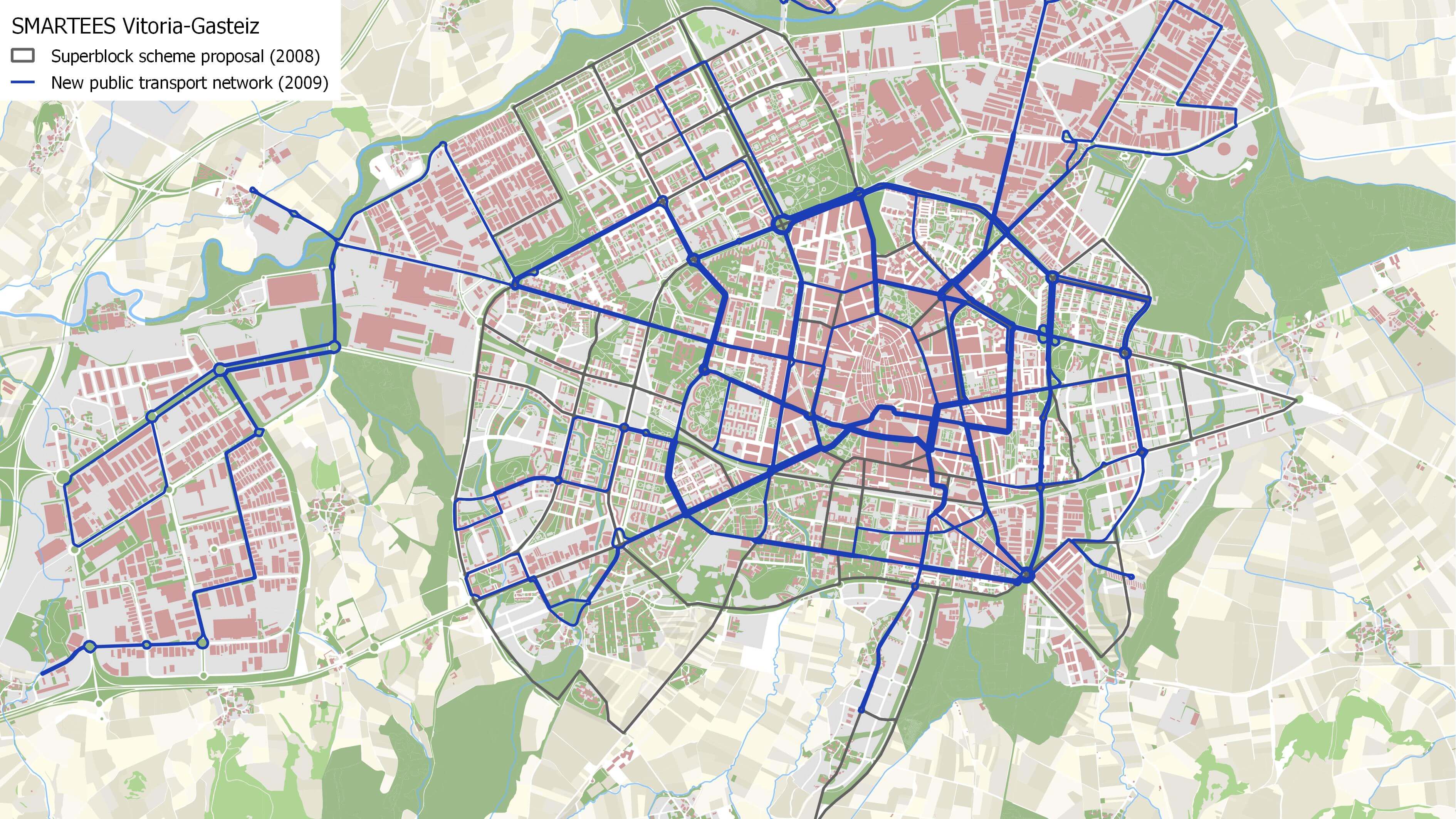
The most important factor in this phase is urban growth: Between 2000 and 2008 the population of Vitoria-Gasteiz grew by 7% and two new residential neighbourhoods were developed. As a direct consequence, an increase in car emissions per capita, from 2.3t CO2 in 2000 to 2.8t CO2 in 2006, was measured. In addition, there was a low use rate of public transport. The bus system was especially considered to be non-competitive with private cars, due in part to the low frequency of buses, which would come only every 15 to 30 minutes.
Against this background, in 2008 the City Council aimed for public transport to become a reasonable alternative to the use of private cars. The improvement of the public transport network consisted of the introduction of two tram lines (in 2008) and the restructuring of the bus network (in 2009). The modernisation of the bus network involved a new design of the routes, the reduction of the number of lines, changes in the location of bus stops and the possibility to transfer between lines.
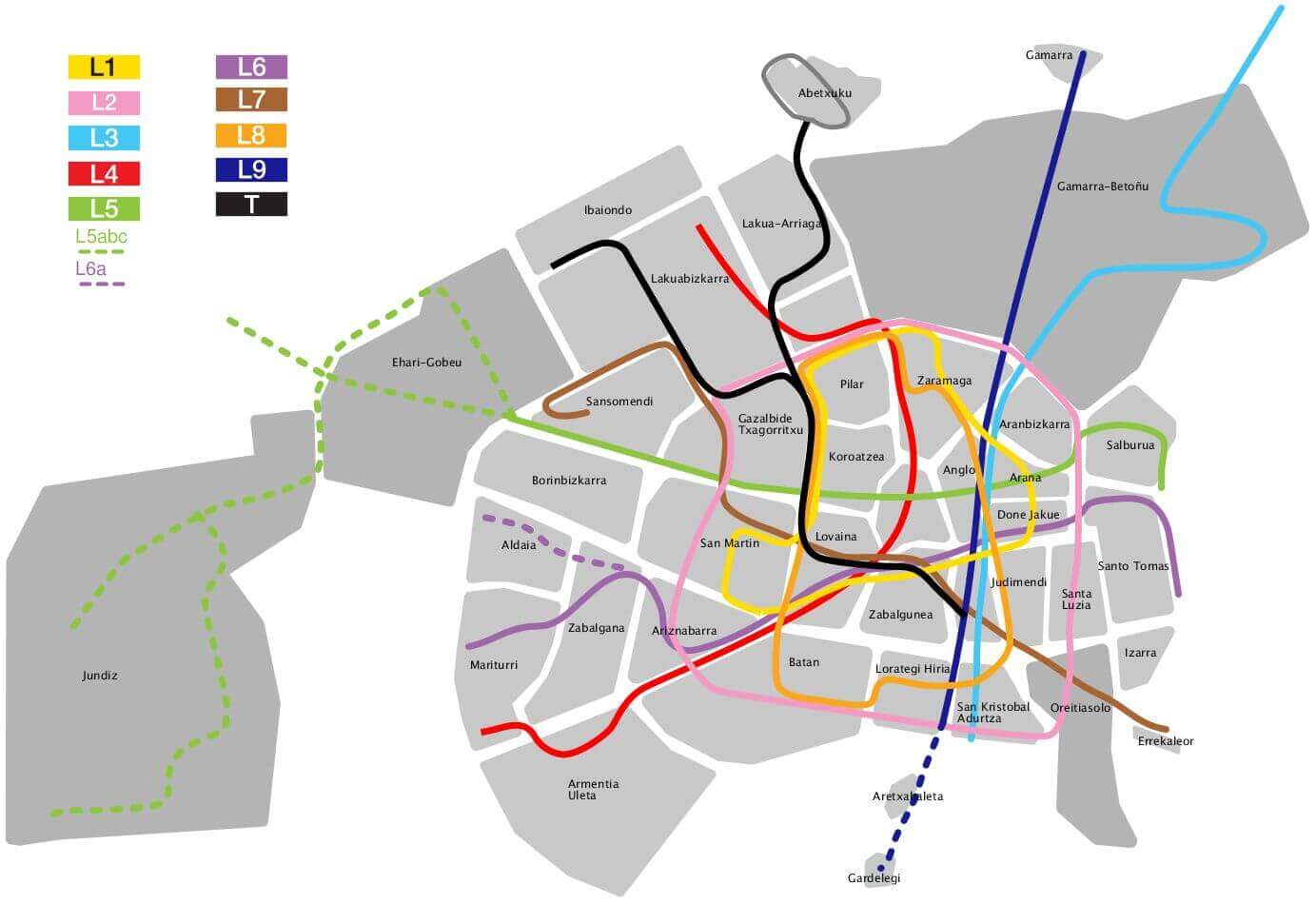
Public transport network © Asier Sarasua Garmendia
These measures increased the speed of public transport and allowed for coverage of the newly built neighbourhoods. The fleet was further adapted to meet the needs of people with disabilities. The measures resulted in a significant increase in the number of users; during the period between November 2008 and January 2010, the number of journeys by bus and tram increased by 43.5%.
Resident associations and citizens were consulted on the implementation of the Sustainable Urban Mobility Plan. The Citizens' Forum for Sustainable Mobility of Vitoria-Gasteiz interacted mainly with the City Council, but also with municipal departments (see the Social Innovation box).
Local media was a key actor that provided meaningful information and large coverage of the policy measures for several months, including a media campaign by the City Council (see Social Innovation box).
The University of the Basque Country was strongly involved in the personalised information campaign that was carried out by volunteers (see Social Innovation box).

Vitoria-Gasteiz successfully changed its public transport network in 2009. This step was marked by the great participation of stakeholders. Under the umbrella of the Citizens' Forum for Sustainable Mobility of Vitoria-Gasteiz, the City Council organised a series of participatory meetings with neighbourhood associations as well as municipal entities, such as TUVISA (which is responsible for managing the public bus system), the Traffic and Mobility Service, the local police, the Department of Economic Development, and the Department of Environment and Public Space.
Public engagement took place in two different phases:
PHASE 1. Public consultation about the public transport plan: These public meetings aimed to explain the overall objective of the Sustainable Urban Mobility Plan. A few neighbourhood associations opposed the plan at the beginning of the process, but their demands were accepted by the local officers, who then took their proposals into account.
The fact that both local government representatives (e.g. the City Counsellor for mobility) and the City Council technical staff participated in all meetings and were open to suggestions and feedback on the SUMP proved to be a key element for dealing with critique and ultimately creating acceptance.
PHASE 2. Implementation of the new bus network: A large communication campaign took place over a six-month period:
- Summer 2009: an advertising campaign was launched in which residents of Vitoria-Gasteiz announced their wishes and the details of the new bus network were unveiled.
- September-October 2009: A three-week communication campaign took place with the aim of reaching the city's whole population with a positive and motivating message towards changing the mobility model.
During the communication campaign in Autumn, 150 volunteers served as "ambassadors" among their fellow citizens, offering information on the matter at different stands distributed throughout the city and reaching more than 35.000 inhabitants. Overall, 100.000 brochures and 75.000 maps of the new bus network were distributed. In October 2009, free bus rides were offered during the week before the opening of the new bus network. Volunteers travelled on the buses to inform users about the changes. During the opening week in November 2009 bus transport was made free of charge again.
2009-2010: Pilot superblock Sancho el Sabio
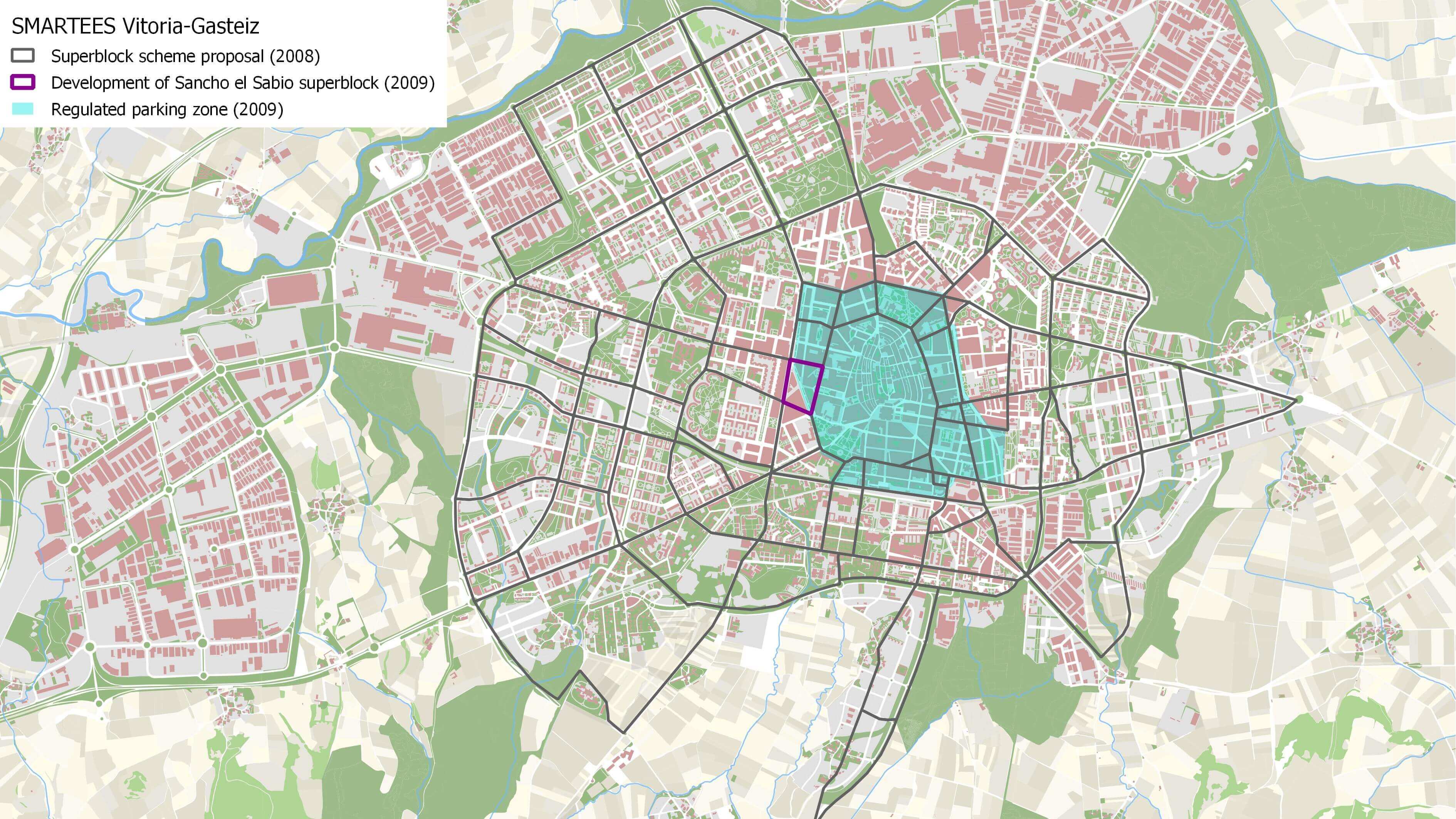
Before the Sustainable Urban Mobility Plan (SUMP) was agreed upon, more than 70% of public roads were reserved exclusively for the use of private cars - despite nearly 70% of journeys in Vitoria-Gasteiz being carried out on foot. The SUMP aimed to extend space for pedestrians. In addition, due to the impact of traffic, more than one third of the population lived with higher noise levels than recommended by the World Health Organization and private cars substantially contributed to CO2 emissions in the city.
Against this background, the SUMP foresaw the introduction of a so-called Superblock. The first Superblock was planned as a pilot site in the "Sancho el Sabio" neighbourhood, before extending the model to the entire city.
To support the changes in this Superblock, a new parking policy was introduced in the city centre to dissuade people from using private cars. The new parking policy increased parking prices for existing parking slots and transformed free parking areas into chargeable ones.
Complementary policies included the expansion of the cycling network with 13 kilometres of new bike lanes in 2009 as well as in 2010, through the implementation of the Cyclist Mobility Master Plan. The Centre of Environmental Studies launched an environmental education programme, which involved the school community (20.000 students from 30 schools) in this new model of sustainable mobility. Cycling courses were organised in schools to enhance youth population competences for cycling on streets and interurban roads.
Vitoria-Gasteiz City Council: All political groups in the City Council supported the Sustainable Urban Mobility Plan (SUMP). Neighbourhood and shopkeeper associations were highly active against the organisation of the new parking policy. About 33 neighbourhood associations gathered approximately 13.000 signatures against it. They also manifested their position through street actions and local media.
As a member of the Citizens' Forum for Sustainable Mobility, the local cyclist association "Gasteizko Bizikleteroak" interacted with a number of city stakeholders and associations. They played a key role in supporting the SUMP and several individual measures. They also expressed their support in the local media.
Local media provided meaningful information and coverage of the different measures that were adopted in the SUMP. Journalists were well-informed voices that mainly supported and fostered a positive public opinion regarding the Superblocks and SUMP measures.
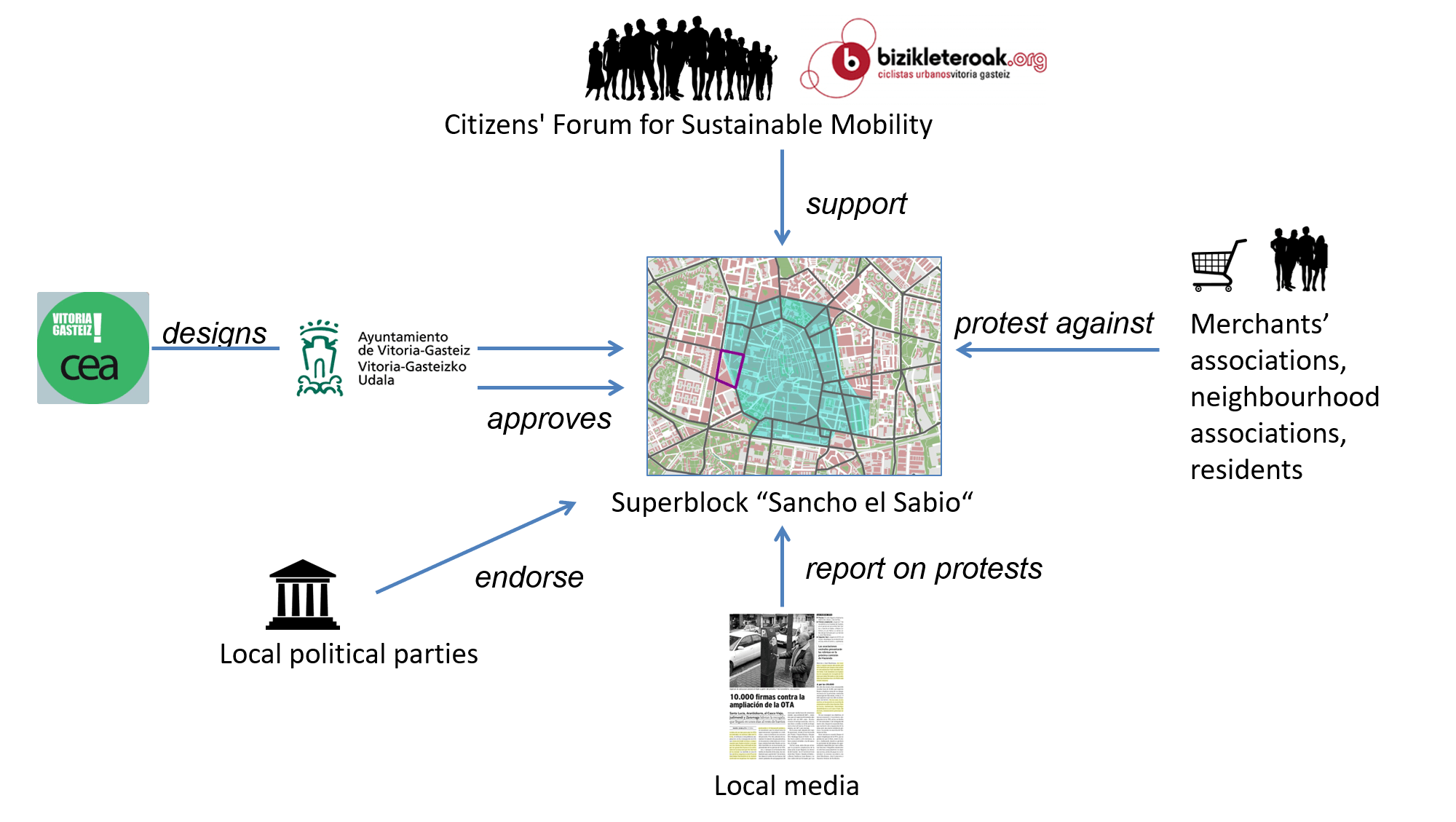
The Superblock implemented in "Sancho el Sabio" and adjacent streets in the neighbourhood, transformed into an area almost free of private cars (providing only one lane for residential traffic). The main changes in the area included:
- Increase in the pedestrian surface from 45% to 74%;
- Establishment of 30 km/h speed limit inside the Superblock;
- Traffic lights synchronisation (to force cars to drive as slow as 30 km/h);
- Elimination of car parking spaces along the streets as well as changes in traffic direction on some streets, preventing cars from passing through the Superblock.
Cyclists were also given permission to go in the opposite direction of cars in some streets, and some roads were narrowed to reduce car speed. An outdoor play zone was created with a rubber floor for children to play.

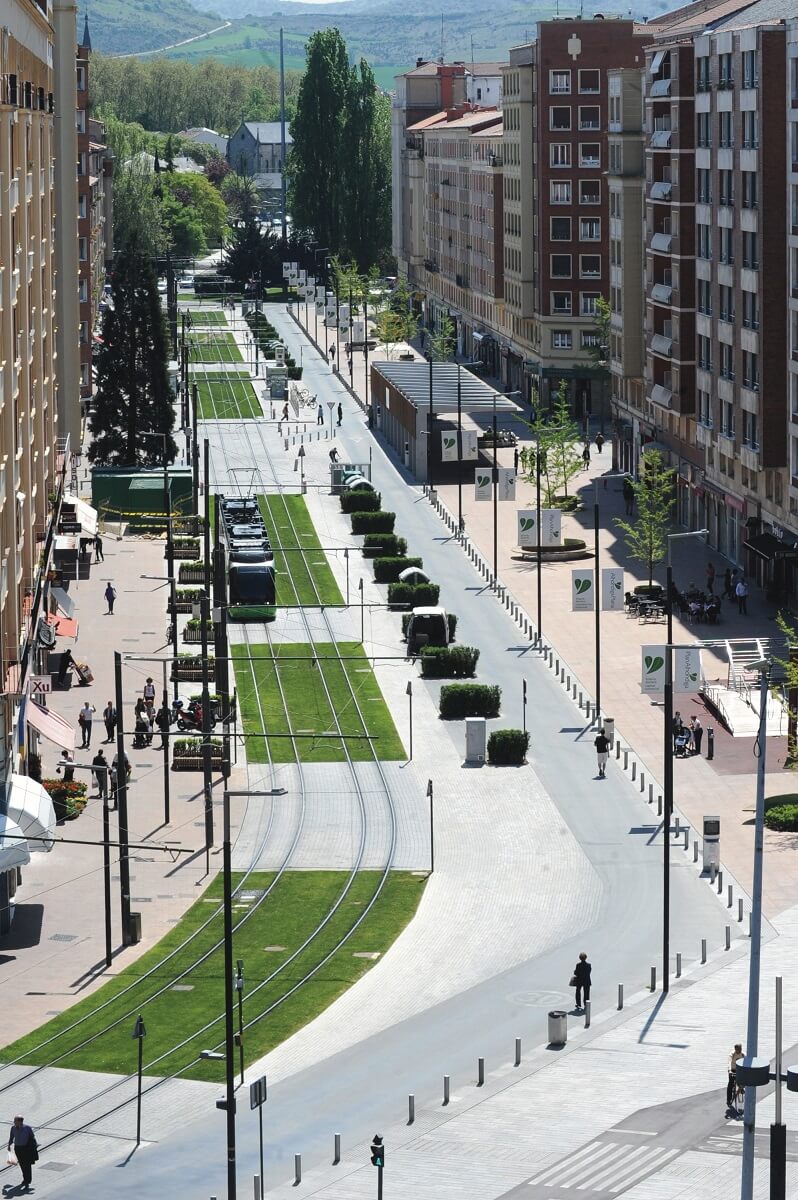
Superblock Sancho el Sabio (before and after), © City of Vitoria-Gasteiz
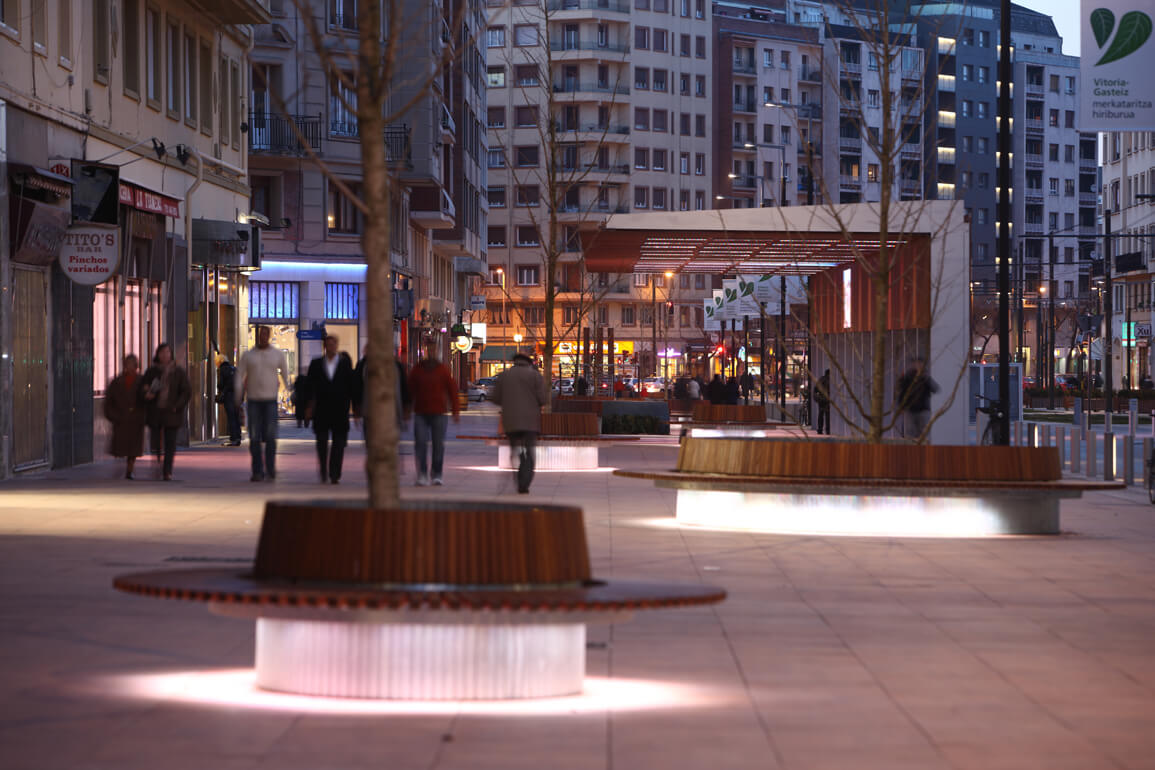
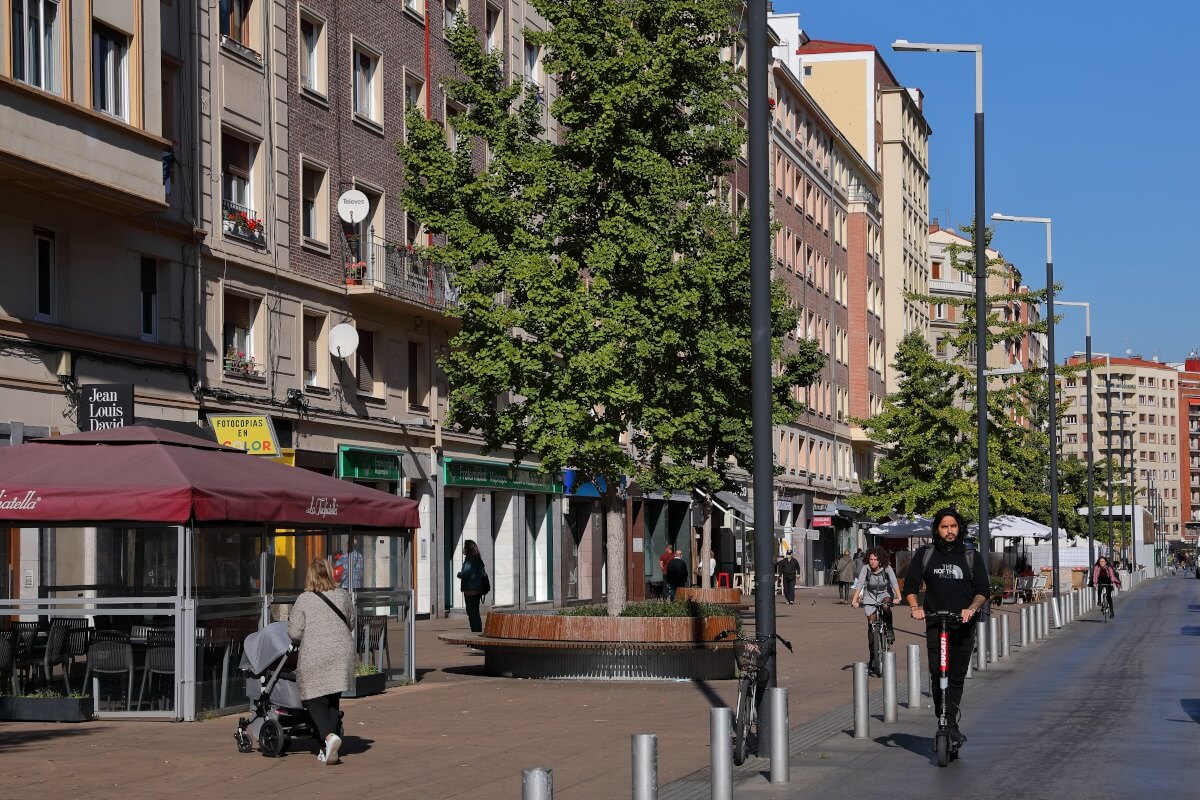
Superblock Sancho el Sabio street level view, © City of Vitoria-Gasteiz
One critical element linked to the implementation of the Superblock was the reorganisation of the parking system through a new parking policy. On the same day that the new bus network was implemented, the rate for private car parking in the city centre was raised threefold. It was a risky decision given its unpopularity. The City Council had to deal with strong resistance from residents in the city centre and the retail sector (see actors). The City Council measured the public acceptability of the pilot Superblock, and a local survey showed that citizens approved of the measure (rated on average 7.43 out of 10 points).
The unity of political action was unanimously recognised as the most important factor during this phase. It enabled the implementation of potentially unpopular actions, allowing for obvious communication regarding a change of direction when it came to urban mobility practices.
Impacts of the social innovation during this phase were:
- The pedestrian surface in the pilot Superblock increased from being 45% of the total surface before the action to 74% after it.
- Noise measured in the pilot Superblock before the action was 66,50 dBA, and after it was 61,00 dBA. The result is directly related to the reduction of motorised vehicles in the zone.
- A 42% reduction in CO2 emissions, 42% reduction in NOx, and 38% reduction in particles (in the pilot Superblock).
- A modal split shift from cars to walking and cycling: walking (66%), cars (23%) and cycling (11%).
2012-2014: Car restrictions in the central superblock
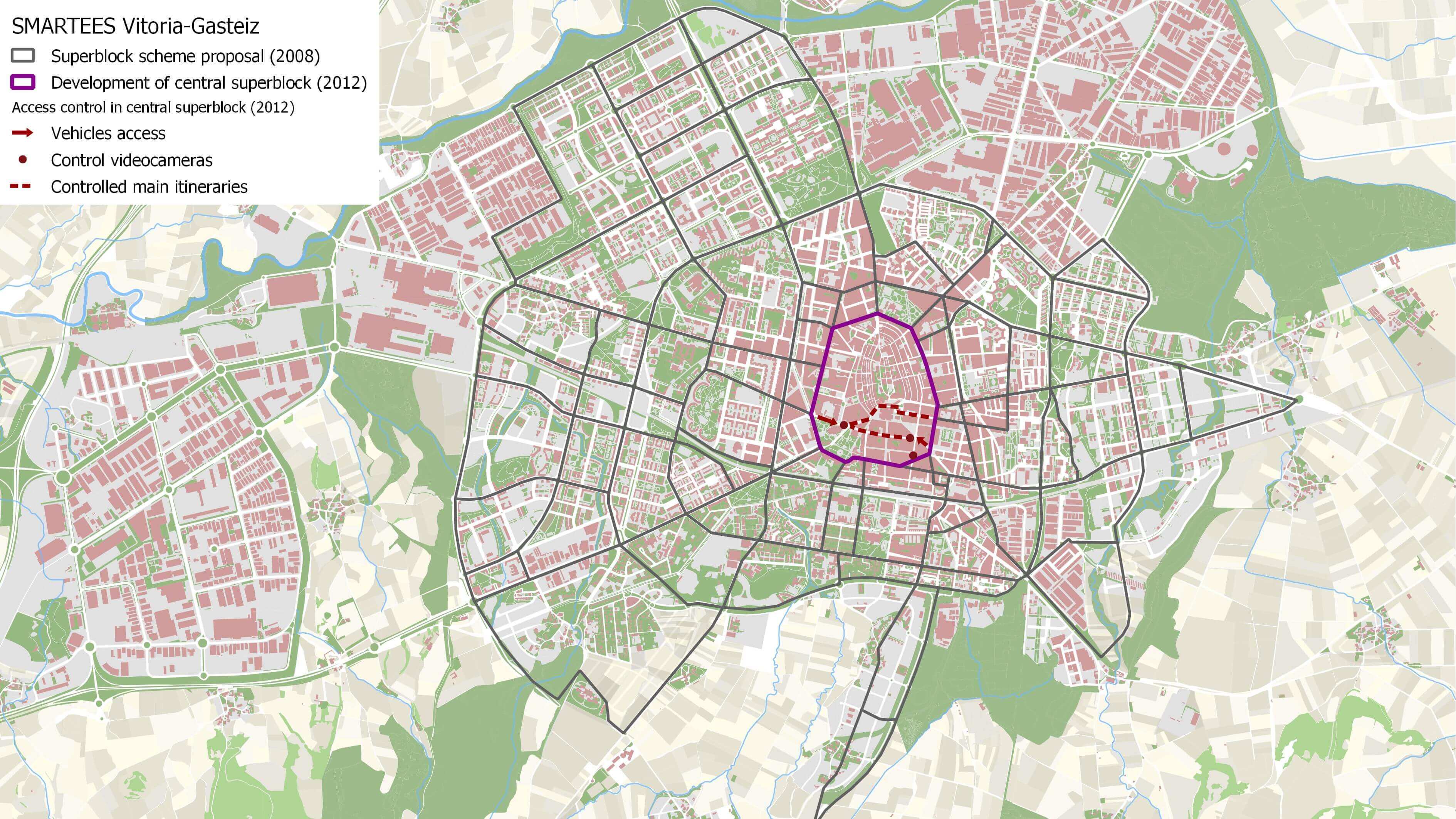
In 2012 Vitoria-Gasteiz was awarded the "EU Green Capital" award and several measures related to sustainable mobility were adopted in the city. The city, for example, launched an innovative scheme featuring bikes as a sustainable form of mobility. The entire network of civic centres hosted numerous workshops and activities for all ages aimed at encouraging active modes of mobility, such as walking and cycling. During this year, thousands of citizens were involved in a range of activities related to environmental protection and raising public awareness about the environmental challenges facing the city.
Until 2012, about 300-400 vehicles per day still drove in the restricted areas of the first Superblock without authorisation. In 2012, therefore, the City Council took additional measures to enforce restrictions on private car access to the "Sancho el Sabio" Superblock by installing video-cameras, putting up information signs, and launching a public information campaign.
Vitoria-Gasteiz City Council: All political groups in the City Council, in line with their support of the Sustainable Urban Mobility Plan, approved the measures.
Continuous support came also from the Citizens' Forum for Sustainable Mobility of Vitoria-Gasteiz.
Local media provided information and expressed a positive opinion about the enforced measures, but it also covered critical reactions from residents and shopkeepers.
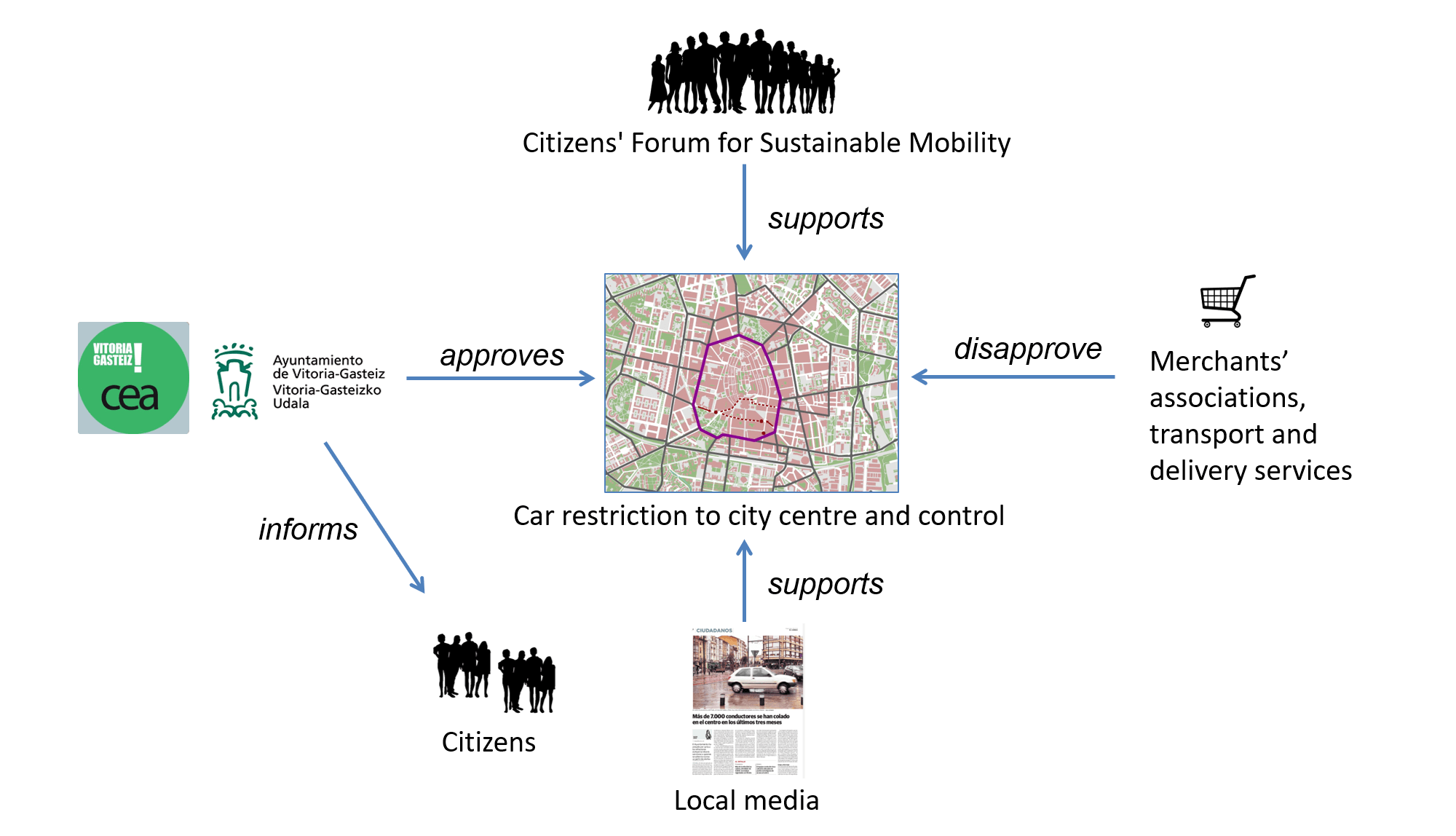
The campaign of personalised information letters to all owners of motor vehicles driving on an area of restricted access:
From April 2012 until August 2012, the City Council launched a campaign and directly contacted, by sending out personalised information letters, all owners of motor vehicles detected by cameras in the Superblock. In these letters, the measures in the framework of the SUMP were explained, accompanied by a brochure that included a map indicating the placement of cameras and restricted access routes. In addition, the letters requested the cooperation of citizens, and also warned that regulatory offences would be liable to a fine.
In the beginning, the measure had little impact on residents. The City Council, thus, extended the communication campaign by five months. In addition to letters, the information campaign was accompanied by a number of communication actions, such as the putting up of information signs and advertisements in the streets or on websites as well as the distribution of an information brochure in shops. The measure was also implemented in a school in the area affected by the restrictions.
A panel survey that was conducted by the City Council (2012-2013-2014) hinted also at social acceptability by highlighting the following changes: walking increased from 49.9% to 54.4%, cycling increased from 3.4% (2006) to 12.3% (2014), and private car use decreased from 36.6% (2006) to 24.7% (2014). Pedestrian infrastructure also facilitated social interaction among residents living in the Superblock.
2016-2019: Replication and adaptation of the superblock model
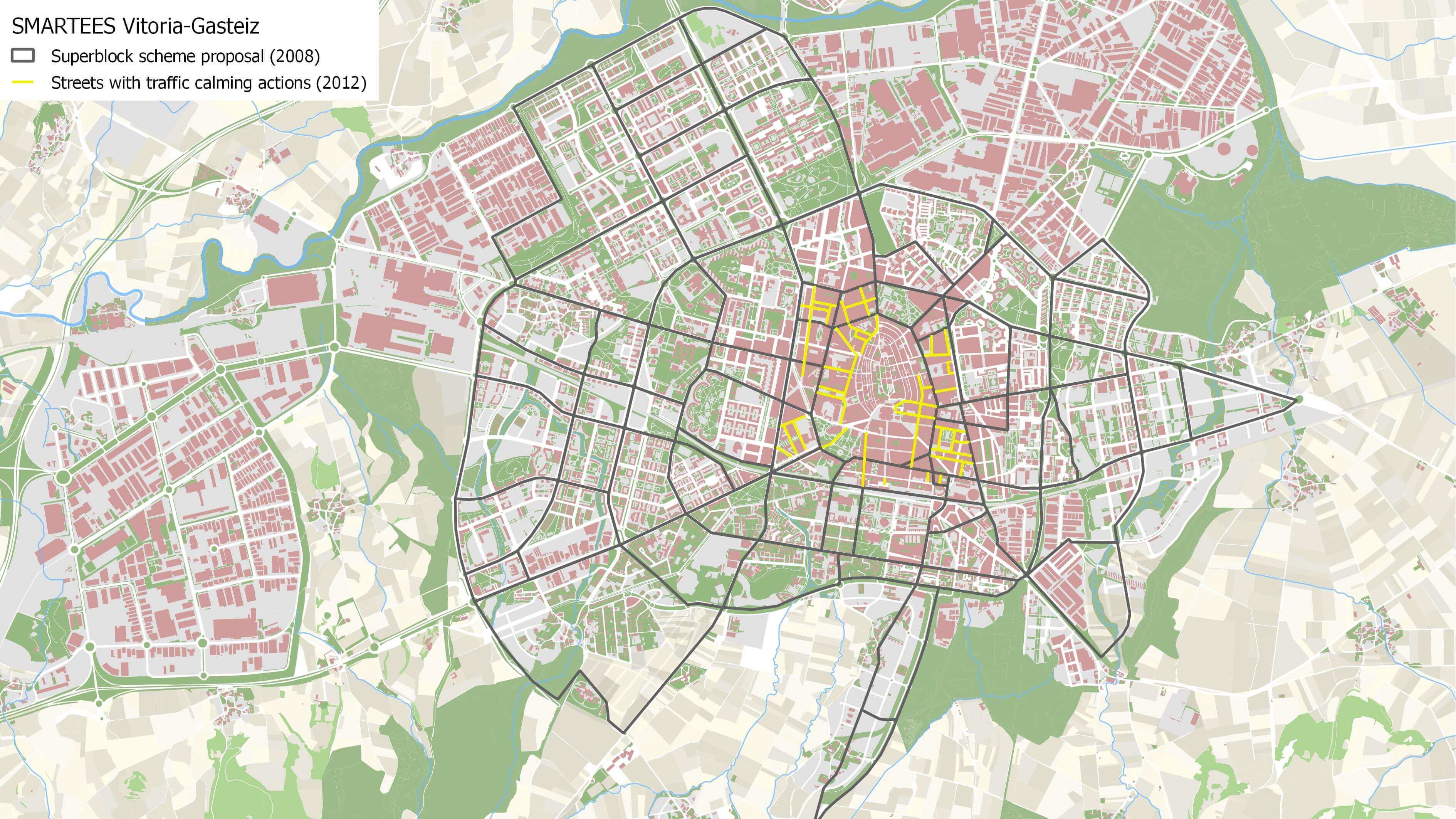
After the 2008 financial crisis, the economic resources available for new infrastructures in the city had substantially decreased. Consequently, the City Council had to adapt the Sustainable Urban Mobility Plan in order for the replication of the Superblock model to be feasible. Tensions between pedestrians and cyclists were a continuous topic, especially in the pedestrian area of the city centre.
Another concern was road safety: recent accidents involving cars and children saw residents protest for safer streets. This ultimately paved the way for the development of Superblocks in other neighbourhoods.
Vitoria-Gasteiz City Council and the Centre of Environmental Studies supported the Superblock approach.
Further support continued to come from the Citizens' Forum for Sustainable Mobility of Vitoria-Gasteiz.
The local cyclist association "Gasteizko Bizikleteroak", was a voice in the media that was advocating for environmental-friendly mobility and demanding safer conditions for cyclists. They made contributions to the new circulation regulation that aimed to restrict the use of bikes on the pavements and they provided expert support for designing new bike lanes in the city.
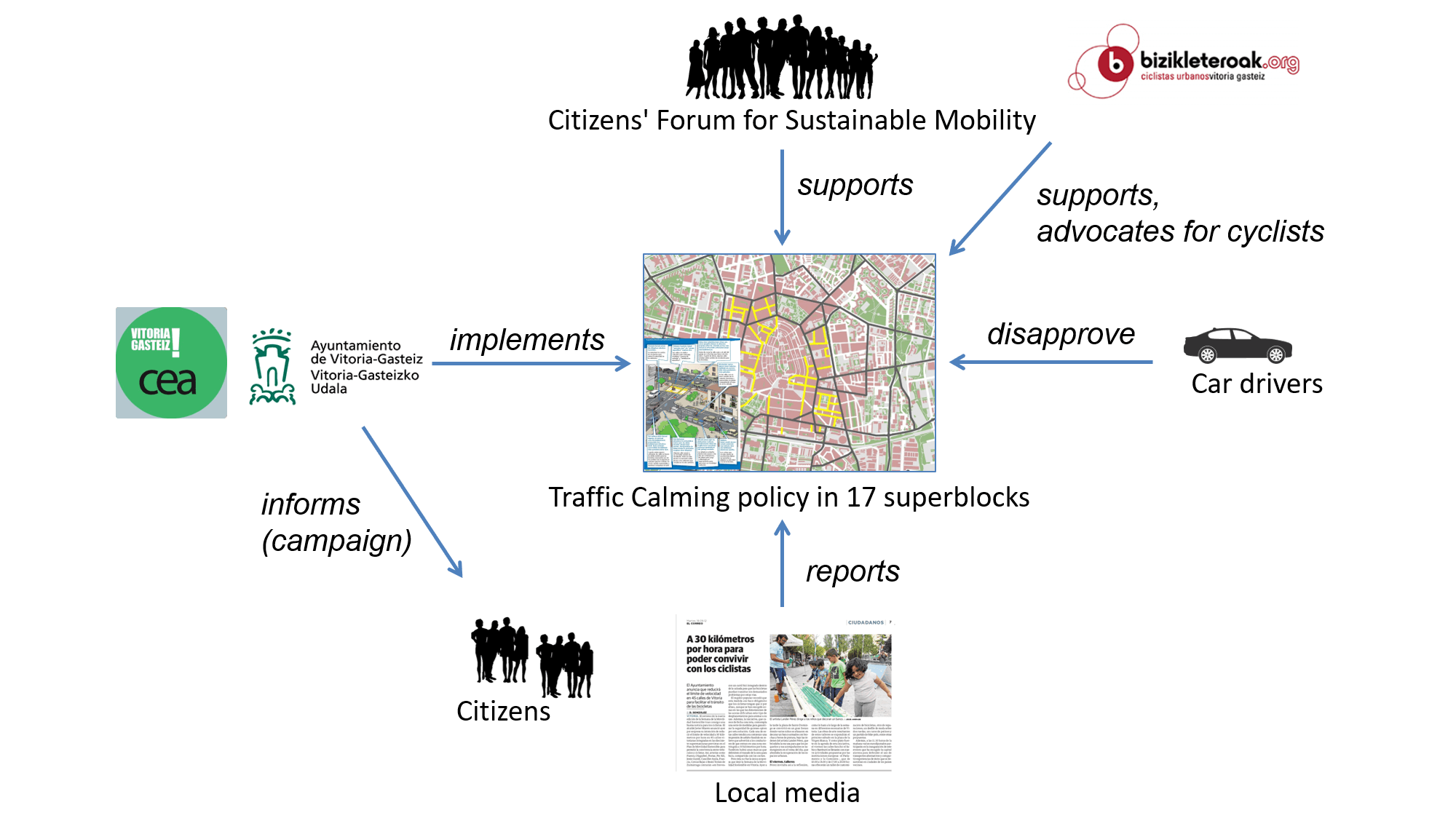
The City Council implemented a traffic policy that slowed down the road speed ("30km Zones") in 47 streets, covering 17 Superblocks. On these streets, motorised vehicles needed to adapt their speed to pedestrians and cyclists – which car drivers initially did not approve.
The City Council launched a specific campaign, in coordination with cyclist and taxi associations as well as public transport entities, to promote safer mobility in the city centre. The campaign "zones 30 – safe zones" was launched to educate cyclists on how to travel on 30km/h zones. The city centre became a cycle area where cyclists share the road with other traffic travelling at a maximum of 30 km/h. This communication campaign consisted of signage on the street, advertisements in buildings and households in the affected areas, radio spots, information on the municipal website and informative brochures that were distributed to all residents.
Click here to see the campaign brochure © City of Vitoria-Gasteiz
The impact of this policy was assessed and the results showed that vehicles travelling on 30km/h zones reduced their speed by 12% on average, cycling safety improved and pedestrians regained space on the sidewalks.
2019-2020: Replication of the superblock model

Vitoria-Gasteiz City Council and the Centre of Environmental Studies (CEA) supported the Superblock approach. The CEA carried out assessments of the Sustainable Urban Mobility Plan, in cooperation with the Agencia de Ecología Urbana.
Further support continued to come from the Citizens' Forum for Sustainable Mobility of Vitoria-Gasteiz and especially its member, the local cyclist association "Gasteizko Bizikleteroak", which was a voice in the media that advocated for environmental-friendly mobility.
A new pedestrian's association "Camina Gasteiz" became very active in denouncing traffic norm violations and demanded more security on the streets. This new association joined the Citizens' Forum for Sustainability Mobility and they worked with other local associations to launch public support actions for the Superblock approach.
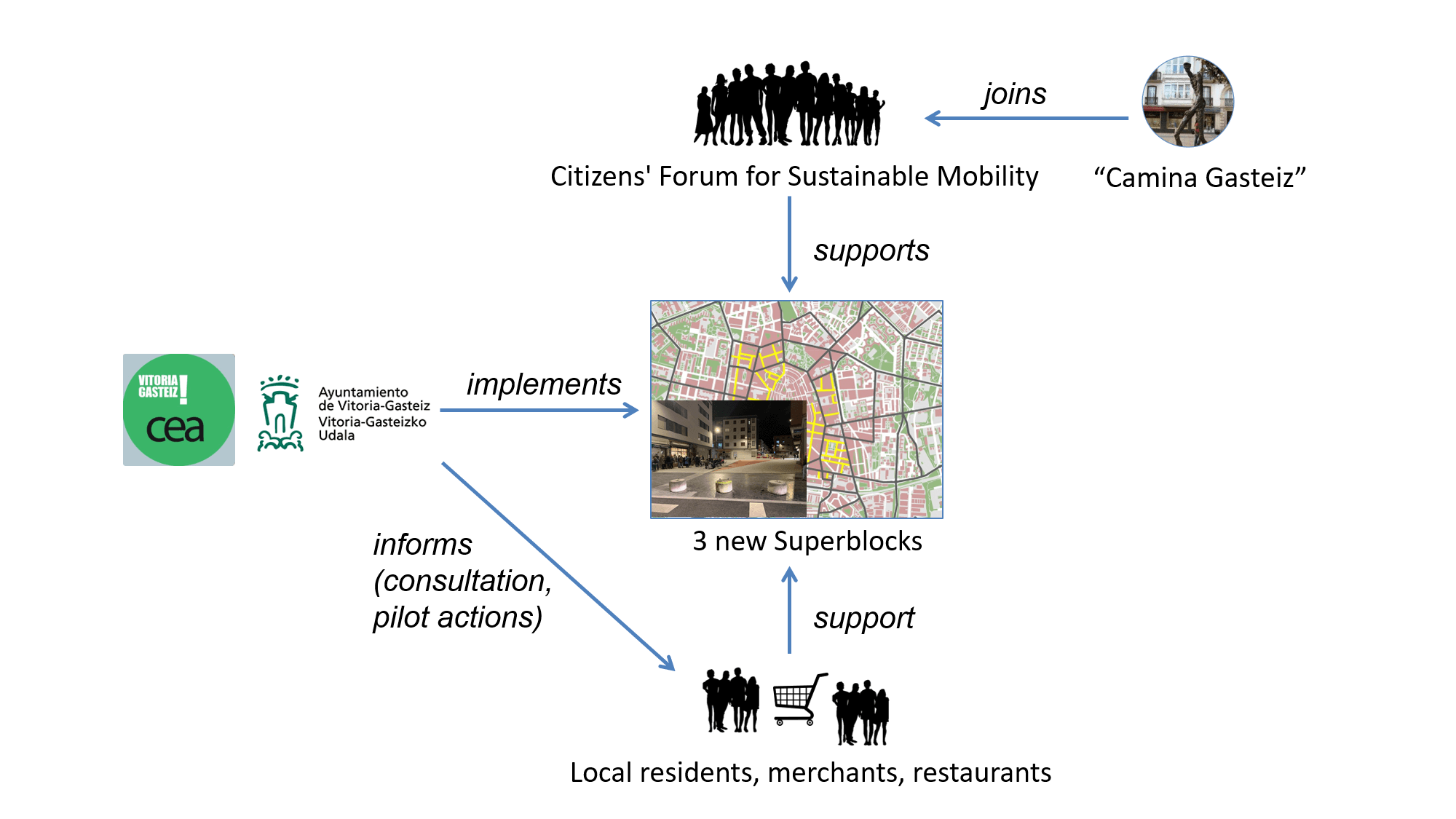
Médico Tornay's superblock
Vitoria-Gasteiz created the core of a new Superblock, upon the completion of the pedestrianisation of Médico Tornay Street and surrounding areas. With the pedestrianisation, the narrow pavements and the space that was previously used for private vehicles were transformed into a large pedestrian space that was intended to be a thriving centre of the neighbourhood, affecting an area of 5.500m2. Monitoring actions showed high levels of social acceptance of this Superblock.
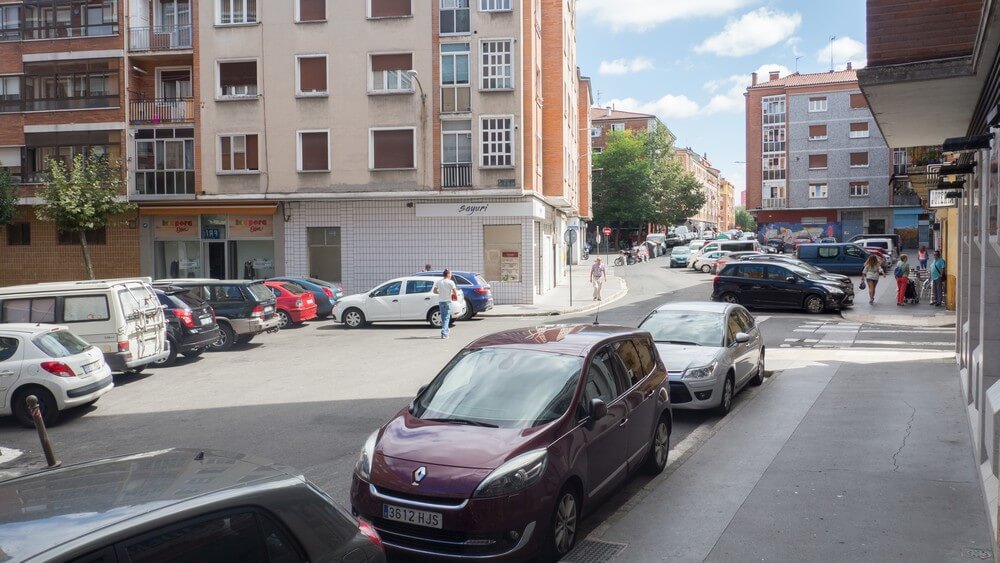
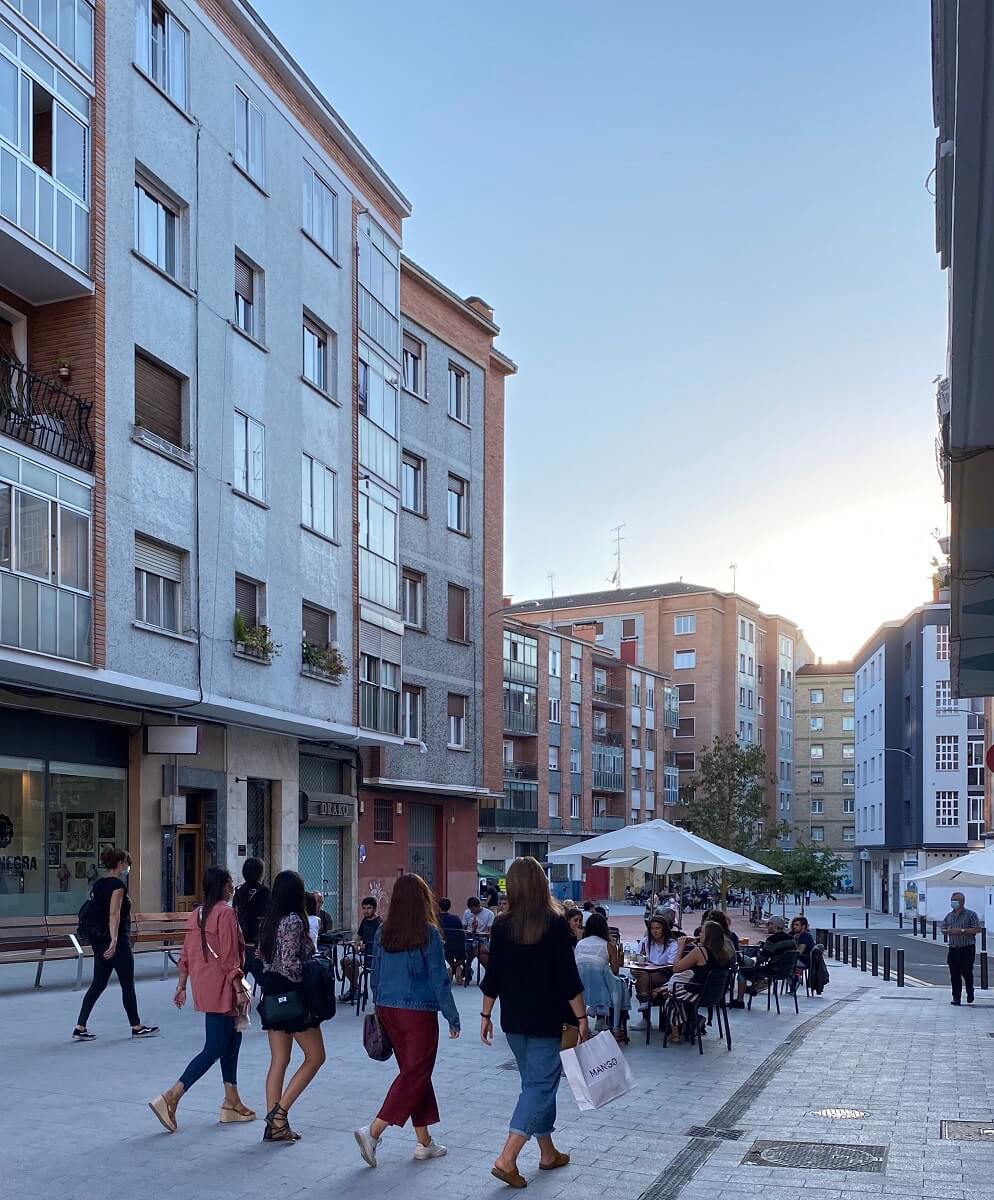
Superblock Medico-Tornay (before and after), © City of Vitoria-Gasteiz
A participatory process with residents and the neighbourhood economic sector was organised to co-design the intervention. A Superblock rehearsal was also conducted in November 2018, which consisted of a one-day car-free action on Médico Tornay Street, recreational and educational activities, as well as an information stand with panels that showed residents the street reform project. This type of participatory action was also reproduced in other neighbourhoods in which a new Superblock was planned.
Superblock in the Memorial Centre for the Victims of Terrorism
The City of Vitoria-Gasteiz rearranged public space, gaining space for pedestrian use, and improved pedestrian and bicycle accessibility in the Medieval Quarter around the Memorial Centre for the Victims of Terrorism by installing escalators and a lift. The project included the modification of the street for motor vehicles, removal of parking spaces, and the creation of new bicycle lanes to connect existing ones.
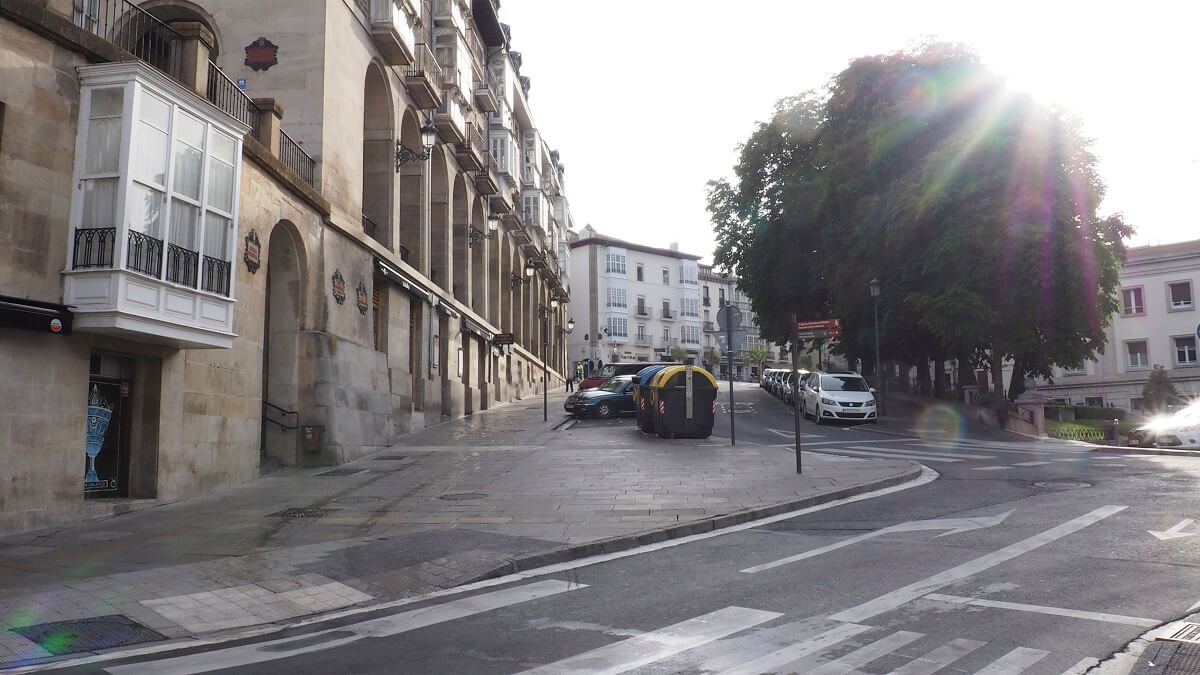
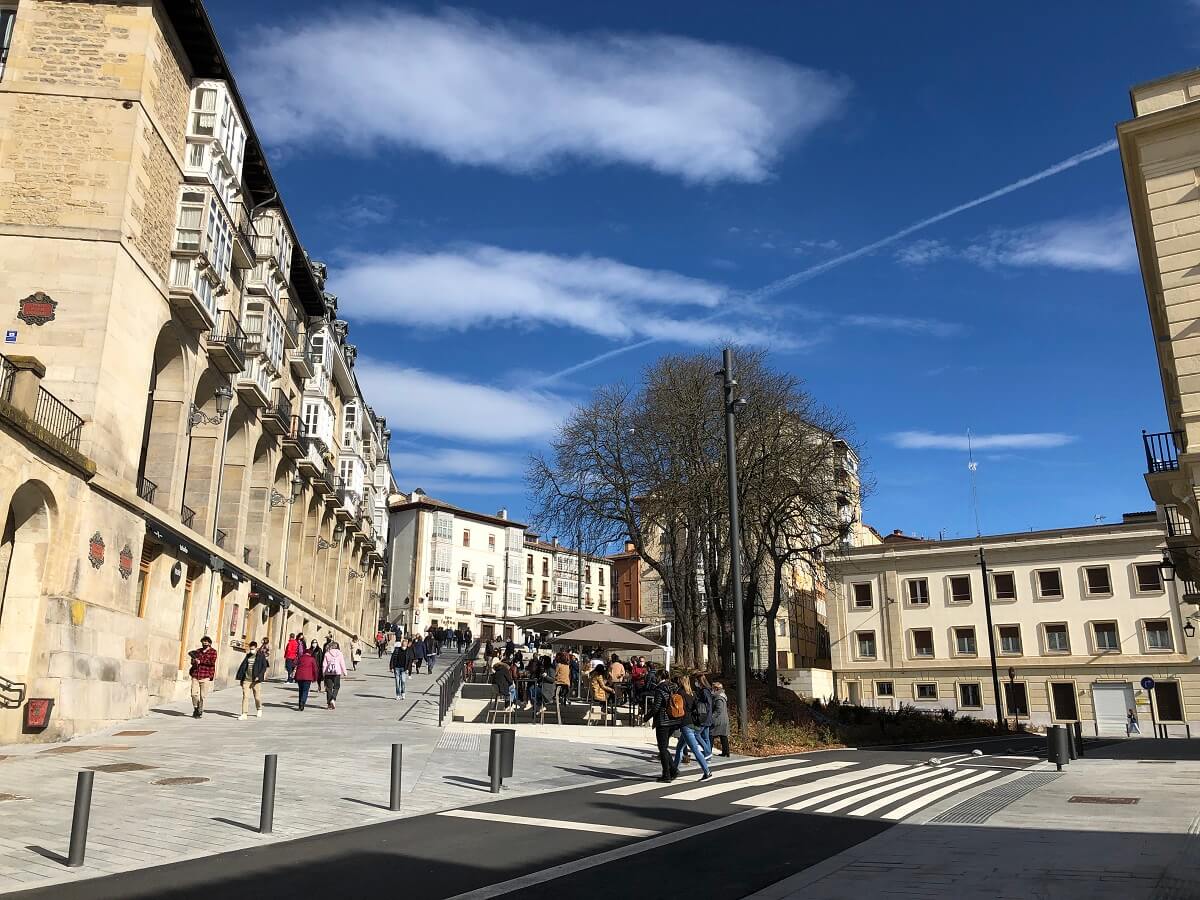
Superblock Memorial Centre for the Victims of Terrorism (before and after), © City of Vitoria-Gasteiz
The Sustainable Urban Mobility Plan was updated to address new challenges such as road safety, commuting to and from work, and the harmonisation of different transport means. In September 2018, the exhibition "Yo me subo +10" was launched, showing the mobility transformation over the years.

"Yo me subo +10" exhibition, © City of Vitoria-Gasteiz
2021 (Present)
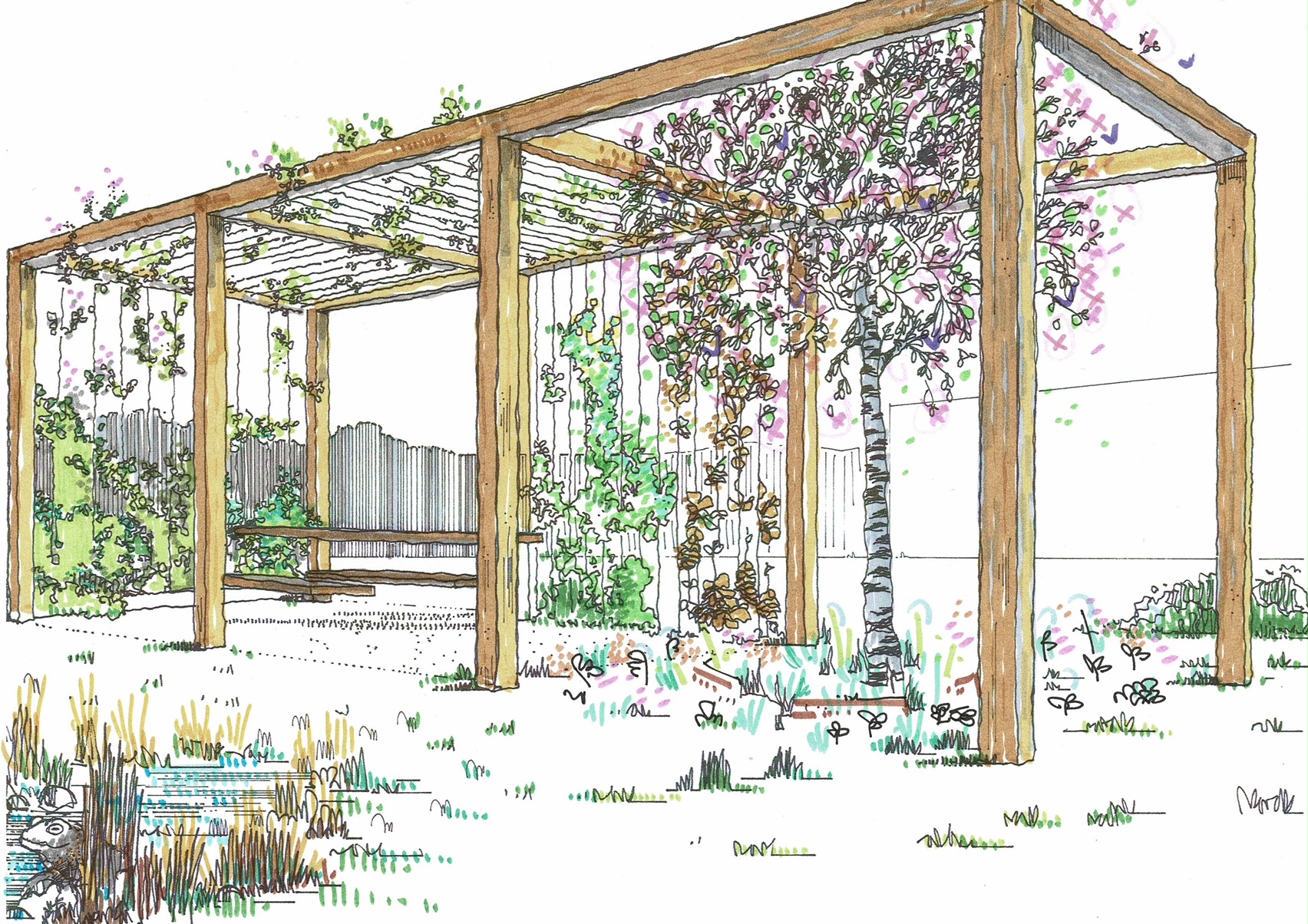
To date, the development has started on 20 of the 77 Superblocks foreseen in the Sustainable Urban Mobility Plan (SUMP) from 2008. Vitoria-Gasteiz is continuously implementing the Superblock model across the city. Currently, five interventions are planned to be implemented in the period 2021-2023 in the Zabalgana neighbourhood.
The implementation of the previously mentioned activities has already proven to be significant, resulting in a number of positive impacts. According to the 2006-2016 evaluation report of the SUMP and the Cyclist Mobility Master Plan of Vitoria-Gasteiz:
- Vitoria Gasteiz has seen the development of a new mobility paradigm in the city, manifested in a shift in transport mode used for commuting.
- The environmental quality of the city has improved, including improved air quality, a reduction in total CO2 emissions, lowered noise pollution, as well as decreased congestion and fuel consumption.
In recognition of the city's effort, Vitoria-Gasteiz has received several awards, including the title of "European Green Capital" (2012) as well as the "UN Global Green City Award" (2019). The SUMP was further rated as a best practice example by UN-Habitat.
Exploration
In the exploration section you will be able to take a look at some alternative policy scenarios in the case of Vitoria-Gasteiz – and how they have been modelled using Agent-based Modelling (ABM). Before you explore the videos, find out what ABM is about in the introductory video below.
Now, you should be ready for the policy scenarios. For the Vitoria-Gasteiz case you can explore a baseline video run, replicating what really happened in the case, as well as three alternative scenarios. Each scenario looks at the impact of a specific measure or event that deviates from what has factually happened in the past.
Summary
We hope this Policy Sandbox Tool storyboard provided some interesting insights and ideas for supporting energy and mobility transitions.
For a final refection on the ABM models that you have seen in the exploration section, see the video below.
For more information on the cases you can take a look at the following resources:
- SMARTEES website – Cluster on Urban mobility in superblocks.
- Our SMARTEES video about Sustainable Mobility in Superblocks: Vitoria-Gasteiz.
- Multiple videos have been made about the Superblocks in Vitoria-Gasteiz, both in English and in Spanish – heralding it as the champion in establishing this concept.
- For analyses and results across the SMARTEES project, look at our reports and deliverables.
- Find two comprehensive studies about Vitoria-Gasteiz's approach; one is a review of the SUMP, the other is a programmatic paper on the idea of a human-scale city.








